Diagnosing and Fixing a Non-working Axis

Are you pulling your hair out trying to solve issues with your CNC machine? Maybe the X-axis has decided to play hard to get? Don't fret. In this video, I'll walk you through the intricate maze of CNC electronics, from transformers and drivers to contactors and controllers. We'll diagnose a real-world problem with the X-axis of a CNC machine, using nothing but methodical testing and common sense. So, grab your multimeter and let's turn that blinking error light into a green light of glory.
Read more.
Pokeys57CNC CNC Interface Introduction

The PoKeys57CNC interface board is a versatile connection between your computer and your CNC Machine or CNC router. Use this interface to connect up to 8 motors, pendants, LCD, a wealth of inputs and output, and the ability to add sensors for really creative projects.
Read more.
A Typical CNC Electronics Retrofit
Welcome to an in-depth journey into the world of CNC electronics retrofitting. In this post, we’ll explore the intricacies and challenges of a 6-hour retrofit project, condensed into an enlightening experience.
Read more.
LaserCAD Installation for the Anywells Laser Controller

How to install the LaserCAD Trocen Anywells Laser Cutter Controller and CAD software.
The Software to be installed is called LaserCAD and is the software that allows communication between the computer and the laser cutter controller, but it also allows you to draw geometry, add text and images and download that file to the laser cutter controller.
Read more.
Cutting Aluminum Fail Using a Cheap End Mill
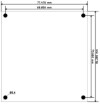
In this video we’re cutting an aluminum ring from a solid block of 6061 aluminum. The client gave us specifications that the ring needs to be 1 and a half inches in length, about 4 inches for the outside diameter, and about 1/4 inch for the wall thickness.
Read more.
How To Start Your Own Makerspace or FabLab
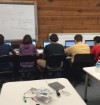
Starting a Makerspace / Hackerspace / FabLab is a great opportunity to capitalize on the booming maker movement while also enriching your local community with the resources to realize their own creative capabilities. If you are interested in creating your own maker-oriented business here are some things you should take into consideration.
Read more.
Cable Carrier Demonstration and Modification Instructions

We started carrying these new cable carriers that contain yellow hinge pins. The construction of the cable carrier is sturdy, but still has great flexibility. With this sturdiness comes the non-intuitive method of modifying the cable carrier. How is it possible to remove links, or put two cable carriers together? Also, how many wires, cables and tubes fit within the cable carriers.
Read more.
How to Determine the Focal Length Measured from the Tip of the Nozzle.

Here, I describe one technique to determine the proper level of the nozzle so you can get the optimum focal length form the tip of the nozzle, not from the lens within the assembly. Trying to determine the length from the lens to the surface to be lased is very difficult because the lens is hidden within the assembly of the nozzle. This technique will allow you to determine this distance from the tip of the nozzle to the working surface.
Read more.
From CAD to Product using the blackTooth Laser Cutter

Here is the complete process (overview) on how to create create a box with using the box joint (finger joint) method. The overview will explain the process of drawing the sides of the box in CAD, applying the machining operations in CAM and finally cutting the parts with the blackTooth laser cutter and engraver.
Read more.
Cutting/Milling Metal with the blackToe CNC Machine
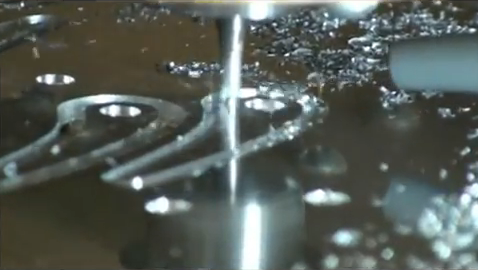
Mark Gottschalk has been cutting metal with his 8 foot long blackToe CNC Machine for a while now. How does he do it? It's a balance of depth per pass, feedrate, the correct end mill and cooling; however, it is possible to cut metals without cooling.
Read more.
Demonstration of Spoilboard Surfacing with an Onsrud Surfacing Cutter
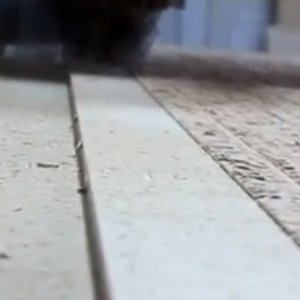
The video below is a quick demo of us doing a bottom clearing on our CNC machine using our new Onsrud Spoilboard Surfacing Cutter. It's generally a good idea to resurface the spoilboard when you first set up your CNC machine. This will make sure the spoilboard surface is perfectly parallel with the X/Y motion of your machine. You should also resurface every so often as the spoilboard surface becomes more uneven over time. This is a better alternative to replacing the board every time it becomes worn down. More in-depth videos on this process later...
Read more.
Cutting Full Depth and Better Dust Removal
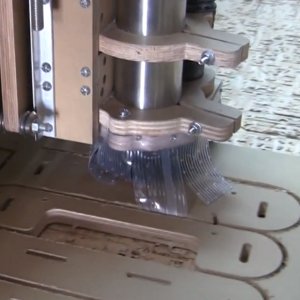
Using our new water cooled 2.2kW spindle has benefitted us with less wear on our end mills and the ability to extract almost all of the dust created from milling. With the higher torque of the spindle, we are now able to mill at full depth, enabling an even wear along the full length of the flutes of the end mill. With the design of a new dust shoe and that the spindle does not use a blower to cool the spindle, dust is better extracted.
Read more.
CNC Halftoning Tutorial
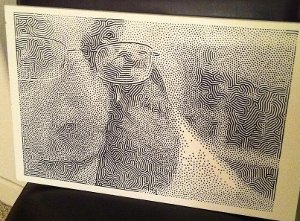
In my usual morning reading, I came across a post at
Evil Mad Scientist Labs showing off CNC halftones using ASCII art. I was compelled by one
link in this post showing a very creative alternative to the usual halftoning done by a CNC machine. The link provides the steps to achieve this effect using your CNC machine.
Read more.
CNC Electronics and Wiring
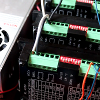
This tutorial will make you an expert in wiring CNC electronics using a parallel breakout board and standard stepping motors and stepping motor drivers.
Read more.
Printed Circuit Board Isolation Routing
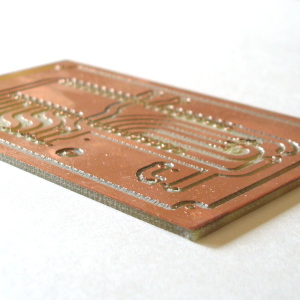
Wiring circuits on a perf board, or trying to get a good etch using laser transfer and harmful and messy chemicals can be a challenge. For a while now, I have wanted to start making my own circuit boards with the CNC machine. The other curious thought is, how will PCB fabrication work with my new design for the roller chain drive. From the tests that I have done, the results are impressive and being so overjoyed, I created a tutorial. I also created this tutorial since there are many hit and miss resources out there, so I wanted to offer a place to get a large bulk of the information to give you a running start.
Read more.
3 and 4 Axis Stepper Motor Driver Board Based on the Allegro Chip
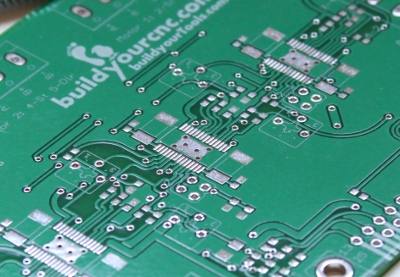
So, what exactly is a 3 and 4 axis stepping motor driver board. Actually, I am presenting the 3 axis stepping motor driver board in this article, but there is another much smaller board that will connect to this one that will provide an additional driver, making it useful for those wonderful 3D projects that use an indexer.
Read more.
CNC Machine Horizontal Work Piece Clamping
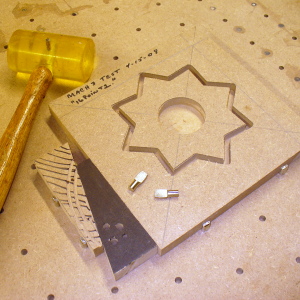
This technique comes from one of the users of this site (Robert L). He has come up with a brilliant clamping idea. I get many emails asking, "how do you clamp your workpiece." I would often reply with the screw and wood scrap idea, but when I saw the method below, I knew this was the one to seriously consider. The historic reference is icing on the cake. When he talks about the moving to various positions, he is making reference to g-code. He specifies, assuming that you have zeroed out the correct position of the origin, that you move to x0 y0... and so on. You would type the g-code: g0 x0 y0 - this g-code moves the bit to the (0,0) position on an x,y coordinate system. You would then want to move the bit downward to create the hole. Depending on your z-axis zero position, say the top of the workpiece is at 0, you would use the g-code: g1 z-0.5 and them immediately g0 z.5 which brings up the bit 1/2" above the work piece. Carry on to the next position of 2" from the x origin by typing: g0 x2. Y is omitted from this since you want y to remain at 0. You get the idea... Now read on and enjoy the simple and effective technique.
Read more.
blackAnt Wall Mounted 3D Printer

The blackAnt 3D printer uses a process called fused deposition modeling (FDM) and has a much larger footprint than its predecessor. This machine is designed to be mounted onto a wall
Read more.
Single Starts, 2 Starts, 5 Starts, TPI, Lead, HUH?!?
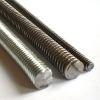
I think it's about time to talk about lead screws. So, what is this lead screw that is always mentioned throughout this website. Lead screws also have all of these terminologies and esoteric language that I will demystify. Maybe you will also start to understand the math behind the linear motion and how different lead screws will provide various linear motion characteristics.
Read more.
Pipe CNC Step 1: Linear Slide Mechanism and Concept
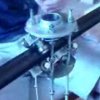 November 22, 2007
November 22, 2007
Happy thanksgiving for those who live in the United States. This is my first post in the Research and Development section of this website. You are probably wondering why I am adding the pipe CNC machine in such an illusive section. I want visitors of this website to know that this machine is a work in progress and all of the bugs and concepts are not fully known yet. Anyway, this enables me to share some of the ideas that run through my head.
Read more.
Technique to Minimize Backlash by Gérard C.
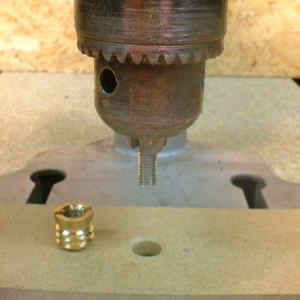
Getting rid of backlash seems to be the biggest concern for the CNC hobbyist, especially when milling PCBs since copper traces for surface mount devices are used. Surface mount devices are very small electronic parts that contain leads that are extremely close together, or the leads are found on the bottom of the component and the part usually lays flat on the PCB (Printed Circuit Board).
Read more.
A DIY CNC Machine in Pipe
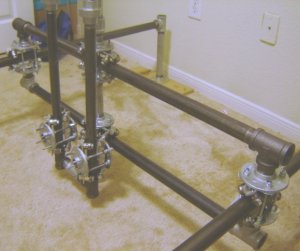
I have been doing a lot of tinkering lately (yup, that's why!). I cannot get the mechanical aspect of CNCs out of my system, so until then, enjoy the crazy concoctions.
Read more.
Bill of Materials
Many of you have asked me to provide a list of materials and costs for the CNC Machine. Here, I will provide a list of the materials, costs and where they can be purchased. In the list, I will also include various alternatives for different types of applications. This may include types of cutting tools, types of motors for the axes, etc. I will keep this list alive and updated in the "stuff for sale" in lieu of a better place. Please write me with suggestions, and if you know of better prices and places to get these materials. This list is a work in progress, since I wanted to make it available immediately. Most prices are from memory, until I find my receipts somewhere in one of my packing boxes, so you may see numbers change, but it gives you a general idea.
Read more.
Some Information about End Mills (Rotational Cutters) for CNC Machines
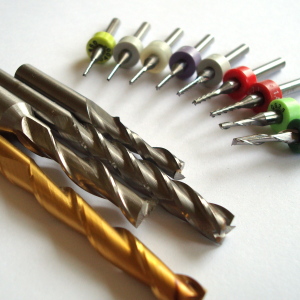
I receive a healthy dose of questions about end mills and which ones that I use. I usually respond with answers like, my end mill will probably differ from your end mill. So, what is this thing called an end mill anyhow? If you are new to CNC machining and routing, you may have never heard of the thing. I could imagine googling something like, "CNC bits". Using the terminology "bit" is not all that incorrect. Bits are commonly referred to as drill bits, but routers use router bits. If you're looking to cut various metals and composites, end mills are the tools of choice. However, end mills will also work on wood, depending on the type of end mill selected.
Read more.
The CNC Process: From CAD to Product
I have put together a video tutorial of the entire process from drawing a part in CAD (Computer Assisted/Aided Design) to the final product that is cut out from the CNC machine. This three part series will step you through the design of a very simple object that uses drills and profiles. Drills are simply holes created from the end mill (router bit) into the material and profiles are horizontal cuts, usually in geometric form, that create various shapes.
Read more.
Torque and Linear Motion Formula
Periodically, I get questions from users of the site regarding torque and how much is required to move certain masses and a recent user emailed me specifically and it gave me the happy motivation to add this page. :) These masses are things like the gantry, or the z-axis assembly with the router mounted moving on the y-axis, or the just the router mount and router within the z-axis assembly. The question is usually in the form of, can my ??? oz-in motors be used on your CNC machine.
Read more.
CNC Machine Pecking
So, what does a woodpecker do? It pecks, and the pecking is to bore a hole. It would be very difficult for a woodpecker to bore a hole in a tree with just one thrust into the tree. The same goes with machining various materials. I previously mentioned pecking in a previous page, but I think it's important to mention it with an example.
Read more.
Step 34 - Software Toolchain Part 1 - Mach 3 Installation
Now we come to the software section of this tutorial series. What's a software toolchain anyhow? Well, my fine feathered machinist... A software toolchain is a "chain" of software that enables the completion of an entire process from design to implementation. When I say chain, I mean a few programs.
Read more.
Step 35: Software Toolchain: EMC2 Under Linux
Before I get farther in the software toolchain for the Windows operating system, I will cover the primary software for Linux. If you are partial to Linux, or you think Linux is some kind of animal and don't know what the heck I'm talking about, this alternative software toolchain may interest you. This tutorial would not be complete without covering the open source side of CNC computer controls. You may find that using
EMC2 (the CNC control that runs under Linux) may be a bit more problematic than Mach3 since there is limited CAD (design software) out there for the Linux operating system. Yes... I said, operating system. I you don't know already, Linux is an operating system about as old as the Windows operating system.
Read more.
Step 33: Router Mount Part 4
This tutorial is dated, if you are considering a CNC for your personal use, we would highly recommend
purchasing a kit that is very stable from our wide range of machines available.
This is the final step for the first phase of the router mount. I say first phase, because I will build a vacuum attachment that will also serve as an additional router mount. You will see the method at which I mount the router in this video. Instead of routing out a perfect circle, and we all know how good I am at routing out circles, and squeezing the circle around the router housing, the router mount will come in two parts and act like a vice. I did not want to put any undue stress on the wood by using the squeeze method, but it woks fine. I used it on my last machine and I had no problems and I even used only 1/2" thick MDF for the mount.
Read more.
Step 32: Router Mount Part 3
This tutorial is dated, if you are considering a CNC for your personal use, we would highly recommend
purchasing a kit that is very stable from our wide range of machines available.
I'll bet that you didn't think that the router mount for a CNC machine would take so long to build. This is probably why I waited so long to build it. All of the parts of this CNC machine is so easy to build. The router mount really is much more complex with all of the curves and the need to mount a pretty heavy router is not that easy, but don't let that scare ya'.
Read more.
Step 30: Router Mount Part 1
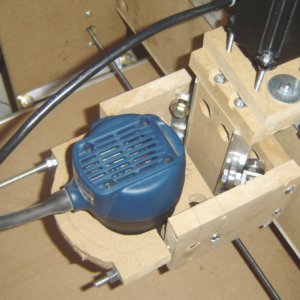
This tutorial is dated, if you are considering a CNC for your personal use, we would highly recommend
purchasing a kit that is very stable from our wide range of machines available.
The first of the videos for the router mount is finally edited and ready to post. The z-axis bearing supports were made in the current shape to be able to hold the router with a piece of stock in-between containing a hole for the router. This hole will need the ability to tighten against the router for stability and leveling. For my machine, I'm making one mount. This router mount will be positioned around the upper part of the router housing. Later, I will be installing a vacuum connection which will also serve as increased support for the router.
Read more.
Step 29: Heat Sink and Driver Connections
This tutorial is dated, if you are considering a CNC for your personal use, we would highly recommend
purchasing a kit that is very stable from our wide range of machines available.
Yes, we've used heat shrink, but now it's time for a heat sink. No, it's not a hot tub. A heat sink is usually a piece of metal that allows something that gets hot to dissipate the heat. It is advised for the three driver chips on the HobbyCNC board. The installation is straight forward. Holes are marked and then drilled. It is important to note that the drill will create many metal shavings. Metal shavings are incompatible to the proper functioning of the driver board. If any of those shavings get on the board, you will risk a blown chip. Before final installation of the heat sink, a white compound should be spread between the component and the metal, like a peanut butter sandwich.
Read more.
Step 27: Y-Axis Motor Wire Connections
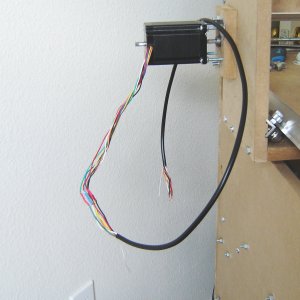
This tutorial is dated, if you are considering a CNC for your personal use, we would highly recommend
purchasing a kit that is very stable from our wide range of machines available.
Now we come to the wire connections. To describe the bigger picture, first mechanically, the motors must turn the screw to provide linear power transmission (movement back and forth). The motor needs power to turn the motor shaft, so the motor connects to the driver board that will accept three motor connections, one for each axis. The driver board is connected to a power supply to provide power to the driver board. The computer is also connected to the driver board to provide step pulse and direction instructions.
Read more.
Step 25: Power Supply Part 1

This tutorial is dated, if you are considering a CNC for your personal use, we would highly recommend
purchasing a kit that is very stable from our wide range of machines available.
Now, we get to the fun part. We get to play with electricity. Well, it's probably not something you want to play with. In fact, be extremely careful. I'm going to provide information that, if not treated with care and respect, is lethal. For those that do not know what lethal means, here is a definition: Lethal = Death. In this case, it's not like quick painless death, but the slow-shocking-melting kind. I've touched 110 volts of house current before, and it's a weird but ugly feeling. Your body understands what alternating current (AC) really means.
Read more.
Step 23: Driver Part 4
This tutorial is dated, if you are considering a CNC for your personal use, we would highly recommend
purchasing a kit that is very stable from our wide range of machines available.
The driver is almost to a completion! We have installed all of the tiny components. Now to the big components. This is the logical process of putting together any circuit kit. The small components are difficult to insert if the larger components are installed already. Believe me, I've tried. Especially if there are jumper wires or resistors needed underneath chips and sockets.
Read more.
Step 21: Driver Caps, Resistor Networks and Mosfets
This tutorial is dated, if you are considering a CNC for your personal use, we would highly recommend
purchasing a kit that is very stable from our wide range of machines available.
The resistors are in, right? Ah, I know, you want to see the complete assembly before you dig in. Ok, on to this part of the assembly. Please don't ask me what Mosfets are, but the word sound cool! I can tell you that they stand for Metal Oxide Semiconductor Field Effect Transistor. I have personally read about fifty descriptions of this electronic animal and I still can't figure it out. It doesn't say much for a Berkeley grad! Well, I'm open to some plain English interpretations without the word "drain" in them. Are you still with me?
Read more.
Step 18: Z-Axis Motor Mount
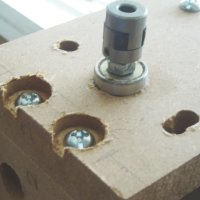
This tutorial is dated, if you are considering a CNC for your personal use, we would highly recommend
purchasing a kit that is very stable from our wide range of machines available.
With the Y-Axis Motor in Place, we can now start on the z-axis. I know you're probably thinking, what are those motors and what are its specifications (torque, what that means, wiring, power, etc.)? That information will be made available during the electronics portion of this video series coming up after the x-axis motor mount. And yes, I'm going to bore you with yet another motor mount. The process wouldn't be complete without it.
Read more.
Step 17: Y-Axis Motor Mount
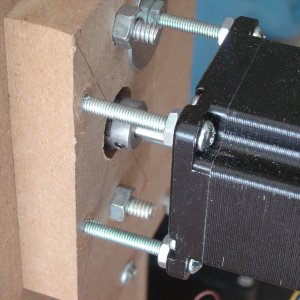
This tutorial is dated, if you are considering a CNC for your personal use, we would highly recommend
purchasing a kit that is very stable from our wide range of machines available. Instead of using allthread for the lead screw and a standard nut, consider using
a 5 start lead screw and anti-backlash nut. It will keep you from pulling out your hair by running much smoother and faster.
We are down to the wire! For the structure of the machine, we only have the three motor mounts remaining. We have recently completed the last two screw assemblies (x and y). The machine now is stiff as an MDF board and won't move anymore. It was more fun without the screws, wasn't it. Now we need to add a method of spinning power to these screws. We can't just use our fingers to turn the screws, but we could attach steering wheels if you're looking for a manual routing machine. We won't be able to call it a CNC anymore, however.
Read more.
Step 15: Y-Axis Lead Screw
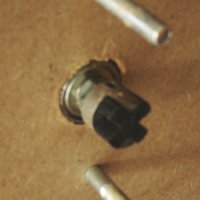
This tutorial is dated, if you are considering a CNC for your personal use, we would highly recommend
purchasing a kit that is very stable from our wide range of machines available. Instead of using allthread for the lead screw and a standard nut, consider using
a 5 start lead screw and anti-backlash nut. It will keep you from pulling out your hair by running much smoother and faster.
You've completed the nut in the
last step. What is power transmission without a screw? In this video, I will demonstrate the holes needed for the bearing and nuts for each end and driving the screw. The process is similar to the z-axis lead screw assembly; but the screw is attached at each end. In my opinion, it's not that important to secure both ends of the screw, but you do want to make sure the free end of the screw will not flap around, so some type of mechanism to keep it in place helps.
Read more.
Step 13: Gantry Y-Axis Rail Support
This tutorial is dated, if you are considering a CNC for your personal use, we would highly recommend
purchasing a kit that is very stable from our wide range of machines available.
After this video, the gantry will be fully supported with the bottom support and the y-axis serving as the top support. Isn't it nice that all of these parts are intrinsically related. The y-axis rail support will provide two functions. It's primary function is to serve as the rail for the z-axis assembly. The secondary, but really important function is to help support the gantry tighten around the cutting surface x-axis rail support.
Read more.
Step 12: Gantry Linear Slide Bearings
This tutorial is dated, if you are considering a CNC for your personal use, we would highly recommend
purchasing a kit that is very stable from our wide range of machines available.
Hey, where did that day go?? Man, time is a passin' and I just can't keep up. Well, today you will see the slide bearings for the gantry. These are very long linear slide bearings. They are long for a good reason. First, the gantry is big. Second, the gantry is heavy. Third, the gantry is made of MDF. Fourth, the gantry is made by HAND! Oh, did I say that the gantry is heavy??
Read more.
Step 11: Gantry Bottom Support
This tutorial is dated, if you are considering a CNC for your personal use, we would highly recommend
purchasing a kit that is very stable from our wide range of machines available.
After watching this video, you will see that the CNC router is coming together and starting to make sense. The bottom support of the gantry, if cut to the correct length, will provide enough holding strength to hug the surface rail support (x-axis rail support/surface cutting area). To built the bottom gantry support, all we will do is make more right angle connections. Now you're starting to understand why I made that technique the second step... It's important.
Read more.
Step 10: Gantry Sides
This tutorial is dated, if you are considering a CNC for your personal use, we would highly recommend
purchasing a kit that is very stable from our wide range of machines available.
We are moving right along. We will be making the gantry sides in this video. The gantry is the part of the CNC Router that moves along the x-axis. That's what makes this machine a gantry style machine. The gantry allows the router to essentially float over the cutting surface. The gantry sides consists of two boards approximately 18" x 8" 8" linear slide bearings will also be built in a later video to be used in with these gantry sides. The linear slide bearings are longer than the other linear slide bearings on the y and z axes so the weight of the gantry can be supported. The gantry needs to carry the z-axis, router, and the y-axis with all support pieces. In addition, the force of the motors against the force that the bit and cutting imposes on the machine must be handled by the entire gantry.
Read more.
Step 9: Z-Axis Lead Screw and X-Axis Aluminum Angles
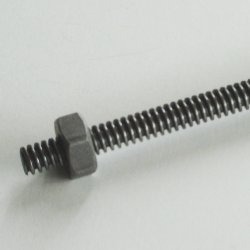
This tutorial is dated, if you are considering a CNC for your personal use, we would highly recommend
purchasing a kit that is very stable from our wide range of machines available. Instead of using allthread for the lead screw and a standard nut, consider using
a 5 start lead screw and anti-backlash nut. It will keep you from pulling out your hair by running much smoother and faster.
Lead screws... hmmm... ok, let's talk concepts. The lead screw is the main component for the transmission of power in a linear form. Yes, a little like the transmission in the car, but much simpler. The screw yields a ratio of force to the linear motion, but conversely affects the speed and resolution of linear motion. To explain in more simpler terms, take a regular screw, and a nut. Hold the nut in one hand but don't turn it. Hold the screw in the other hand and screw it in the nut. Your hand is applying a force to the screw in a circular motion, hence the motor turning the shaft, and if the screw is turning at a stationary point in space, it will pull the nut toward the hand turning the screw. If the turning motion of the screw is reversed, the nut is pushed away from the hand turning the screw.
Read more.
Step 8: X-Axis Front and Back
This tutorial is dated, if you are considering a CNC for your personal use, we would highly recommend
purchasing a kit that is very stable from our wide range of machines available.
We are going to cheat and skip to the x-axis for a minute, well... actually 8 minutes since that's about how long the video is. The CNC router has a table, right? The flat piece that you put the stuff on to cut, right? Well, that piece has this thing called the gantry riding over it. How does that gantry move? It needs to hug this surface and requires a piece underneath. In other words, the gantry cannot move unless this surface is lifted above the ground to accommodate the gantry support and the motor underneath.
Read more.
Step 7: Z-Axis Transmission Nut
This tutorial is dated, if you are considering a CNC for your personal use, we would highly recommend
purchasing a kit that is very stable from our wide range of machines available. Instead of using allthread for the lead screw and a standard nut, consider using
a 5 start lead screw and anti-backlash nut. It will keep you from pulling out your hair by running much smoother and faster.
We will install the method that provides transmission to the z-axis. The transmission consists of a lead screw and a nut. Very simply, the motor will turn the screw, and the nut is fastened to the z-axis assembly, moving the assembly as the motor spins. That is to say, when the motor turns clockwise, the nut will travel up, and if the motor turns counter-clockwise, the nut will travel down.
Read more.
Step 6: Y-Axis Assembled
This tutorial is dated, if you are considering a CNC for your personal use, we would highly recommend
purchasing a kit that is very stable from our wide range of machines available.
The y-axis will now be assembled. Remember
Step 2? Well... this video is all over it! It's all about making the connections. I can't tell you how simple this CNC structure is. The complications come later, don't worry. The real challenge to this structure is trying to get the cut straight, and the holes aligned correctly. Remember, we can cut loose holes to re-align, so it's all good!
Read more.
Step 5 - Y-Axis Bearing and Rail Support
This tutorial is dated, if you are considering a CNC for your personal use, we would highly recommend
purchasing a kit that is very stable from our wide range of machines available.
We are finally to the y-axis. In this video you will see how I built the y-axis linear bearing support and the rail support. First the rail support is similar to the rail support for the z-axis, but wider. This width carries much of the load and the width determines the z-axis length of travel. If you want more z-axis travel, pick a wider y-axis rail support width. In this case, the width to which I'm referring is the short side of the piece. That is... if you made the z-axis travel longer than the length of the y-axis rail, then the width would be more than the length. Did I confuse you yet? I think I confused myself. Well...let's get on with the build.
Read more.
Step 4 - CNC Z-Axis Part 2
This tutorial is dated, if you are considering a CNC for your personal use, we would highly recommend
purchasing a kit that is very stable from our wide range of machines available.
At the rate I'm going, I should be finished with the entire CNC router structure (not including the lead screws, motors, or electronics). Since all of the parts are so intrinsically related to each other, I have been bouncing around. The fourth video, which I will post later tonight, will contain the completion of the z-axis and a part of the y-axis. By the end of the weekend, maybe Monday, all of the videos pertaining to structure will be posted. All of the axes will be sliding and you will start to get a greater understanding of the final product.
Read more.
Step 3 - CNC Z-Axis Part 1

This tutorial is dated, if you are considering a CNC for your personal use, we would highly recommend
purchasing a kit that is very stable from our wide range of machines available.
It's time to start buying our major structural materials for the CNC machine. The base for this machine will be the size of a standard 24" x 48" x 3/4" sheet of MDF. In all, you will most likely use a total of three sheets for this build (I would buy one for now). Your local hardware store should have this in stock. While you're there, you might as well have someone at the hardware store cut it too. Hopefully there will be an assistant that can cut the sheets pretty accurately.
Read more.
Step 2 - The Cheapo Connection
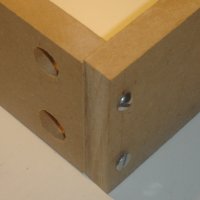 Check here for our cross dowel nuts
Check here for our cross dowel nuts that are used in this tutorial. These are a great way to create joints in wood. If you are looking for some great CNC machine kits,
look here.
Making corners, connecting two pieces of MDF can be a challenge. I am going to run through a technique, and a vital element in the CNC machine of this tutorial. This step is not as glorious as building an actual working component of one of the CNC axes; however, this type of connection is used on almost every part of the machine. The idea is very simple: with two large holes to receive nuts, and two transversal holes to receive screws (long enough to reach the nuts), a tight and strong connection can be achieved. Not only is this connection strong, it also helps to create the tension desired to tighten an axis assembly around the rods/angles for snug no-play sliding. Other types of connections that I have tried are weak and prone to splitting. I have had no splitting or failures with this method.
Read more.
Step 1 - Linear Slide Bearings
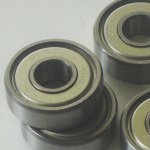
This tutorial is dated, if you are considering a CNC for your personal use, we would highly recommend
purchasing a kit that is very stable from our wide range of machines available. If you are looking for great
linear slide bearings, see here.
Through much of my research on homemade CNC machines, I found that the mechanism to provide linear sliding is simply the use of an angle ("L" shaped piece of metal), bolts or screws (5/16" at 3/4" in length), nuts (5/16") and standard skate bearings (I use ABEC7/608Z). The design is actually very efficient and clutter free. When I say clutter free, I mean that the exhaust of sawdust that the CNC will produce will not clog up these bearings. Collar bearings, or bushing bearings I believe will have the tendency to receive material within the bearing housing creating a binding effect. If you are wondering what a bearing bushing is, imagine a cylindrical tube with little balls housed on the inside surface of the tube. The skate bearing method is like creating a new kind of hybrid inline skates and those skates you used in the 80's with the four wheels (coming back into style, why?!?).
Read more.
To Start: Basics and What You Should Know
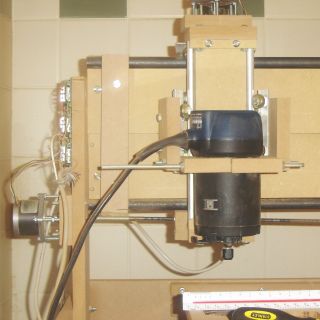
This tutorial is dated, if you are considering a CNC for your personal use, we would highly recommend
purchasing a kit that is very stable from our wide range of machines available.
A CNC machine is probably the most useful tool a hobbyist can own, but the price for a CNC machine on the market is way more than the average hobbyist is willing to spend. Each day I will add video tutorial steps to get you through the build with very basic tools, little knowledge of machinery, mechanics, or electronics; but I must warn you, these machines are inherently dangerous, so wear the proper protection and use common sense. At the very least, read the instruction and precautions on every tool you use. I am especially not responsible for relationships gone bad as a result of the obsession you are about to embark.
Read more.
Terms of Use and Customer Service Policies
After carefully analyzing the existing clients, processes, and time management, and by understanding the benefits of the new customer service approach we are proud to introduce a new customer service policy. The new policy will ensure a better customer service experience and also guarantee a better service to our clients.
Read more.